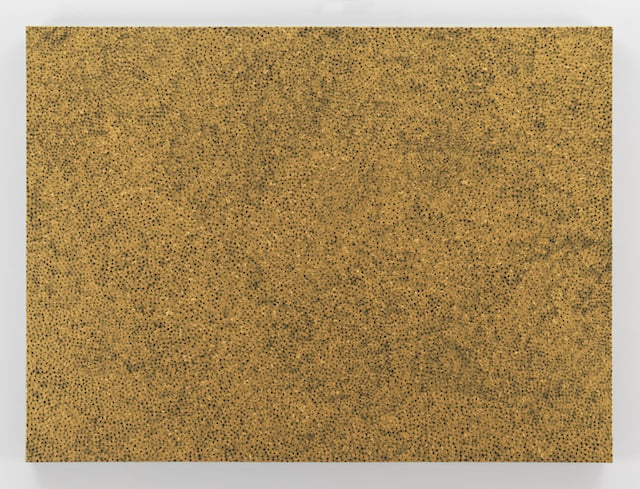
Photo: courtesy David Zwirner Gallery.
Nuno Ramos, Tratado dos Manequins (2015) .
Photo: Eduardo Ortega, courtesy Galeria Fortes Vilaça.
While many dealers approached the 12th edition of SP Arte in São Paulo with trepidation, they were visibly relieved after day one, when thousands of Paulistas descended on the fair. Important collectors from abroad have been also making appearances, including Maxine and Stuart Frankel, of Michigan, and Ella Fontanals-Cisneros, from Miami.
A drastic slowdown in the national economy didn’t dampen the atmosphere, and galleries reported healthy sales.
Sonia Gomes, Untitled, from the Torção series, 2015.
Photo: courtesy Mendes Wood.
São Paulo gallery Mendes Wood, in fact, sold a wall sculpture by Brazilian artist Sonia Gomes within the first few minutes of the VIP opening on Wednesday to a collector who made a beeline for the booth. The gallery is sharing a large space with Michael Werner Gallery, which has venues in New York, London, and Trebbin, Germany. Between them, they’re offering artists from Sigmar Polke to Solange Pessoa.
Still on offer is a striking painting on found wood by Celso Renato, a lawyer-turned-artist who died in 1992; according to Mendes Wood, there are only about two dozen of his works on the market. This one is priced at $250,000.
The early sale of the Gomes is atypical at a fair that, Werner’s Birte Kleemann said, is not exactly like Art Basel, known for a frenzy of sales during the opening minutes.
All the same, Galleria Nara Roesler, with locations in São Paulo, Rio de Janeiro, and New York, had to reinstall a fair portion of its booth, having sold out an edition of kinetic sculptures by Artur Lescher and a few wall sculptures by Abraham Palatnik, all to private collectors.
A detail of a work by Rodrigo Torres at SIM Gallery.
Photo: Brian Boucher.
SIM Galeria, from Curitiba, sold all the works on offer by Rodrigo Torres, which are collages made from currency. Those works were at recession-friendly prices ranging from $1,000 to $16,000.
Still available is a haunting photographic collage by Parisian-born Julia Kater; to create the work, she posed on a pebbly beach with the ocean behind her, and layered the resulting prints after cutting her own figure out, leaving a void at the center. The resulting work symbolizes the disappearance of Middle Eastern refugees trying to make safe passage to Europe’s shores.
Yayoi Kusama, INFINITY-NETS [GXN], 2016.
Photo: courtesy David Zwirner Gallery.
David Zwirner Gallery, with locations in New York and London, brought works ranging in price from $10,000 to north of $1 million. Director Hanna Schouwink reported, just hours into the preview day, that the gallery had sold a Yayoi Kusama painting that would cover the gallery’s expenses for the fair. By the next day, said fellow director Greg Lulay, the gallery had also sold paintings by Oscar Murillo and Sandú Darié, and photographs by Wolfgang Tillmans.
Olga de Amaral, Alquimia.
Photo: © Diego Amaral / Courtesy Galerie Agnès Monplaisir.
Paris gallery Agnès Monplaisir’s Maxime Porto, meanwhile, acknowledges that the gallery has set itself a challenge in aiming to revive sales of São Paulo artist Cabral, owing to his having taken a hiatus from the market. Monplaisir is showing a suite of imposing, paintings with heavy impasto that are devoted to Portuguese King João II. The gallery reported having sold one of the large works early in the fair. The gallery is also offering shimmering, expansive gold fiber works by Colombian artist Olga de Amaral, who has seen a rising market in recent years.
Carlos Garaicoa, Aniversario / Anniversary, 2015.
Photo: Brian Chan, courtesy Galleria Continua, San Gimignano / Beijing / Les Moulins / Habana and Galería Elba Benítez, Madrid.
“We expected to find a very sad situation, and the feeling is much better than we hoped,” said Margherita Tanagli of Galleria Continua, which has venues in San Gimignano (Italy), Les Moulins (France), Beijing, and Havana.
She was standing by a bizarre installation by Cuban artist Carlos Garaicoa inspired by a postage stamp showing Adolf Hitler greeting a young child; the artist later found many more examples of this phenomenon, discovering that the politician-with-child motif transcends borders. Also on view are mirror works by Michelangelo Pistoletto, and a sculpture by Shilpa Gupta, among other works.
Los Carpinteros, Galletas Dulces, 2015.
Photo: courtesy courtesy Galeria Fortes Vilaça.
Alexandre Gabriel, of São Paulo’s Galeria Fortes Vilaça, told artnet News, “We sold more than half the booth,” including sculptures by Leda Catunda, Iran do Espírito Santo, and Erika Verzutti, and canvases by Marina Rheingantz and Lucia Laguna.
Dominating the booth is a relief painting in in intense purples, greens, and blues by São Paulo polymath Nuno Ramos, who’s also known for his award-winning novels. Tratado dos Manequins (2015) is nearly fifteen feet wide and almost a foot deep, and is a newer counterpart to a series of intensely physical works the artist and writer created in the 1980s as a reaction against conceptual art. It’s still on offer at $150,000.
Another surprise is that other works at the gallery were free. We were sitting at a table laden with cookies designed by Cuban duo Los Carpinteros, stamped with words grabbed from the Brazilian headlines. “I’ve been eating ‘corruption’ cookies all day,” said Gabriel with a laugh.
That was one of the few incursions of the grim economic and political situation in Brazil into the space.
“You don’t feel the crisis inside the fair,” said Anapaula Zamacona, with Mexico City’s Kurimanzutto, “and that’s a good thing.”